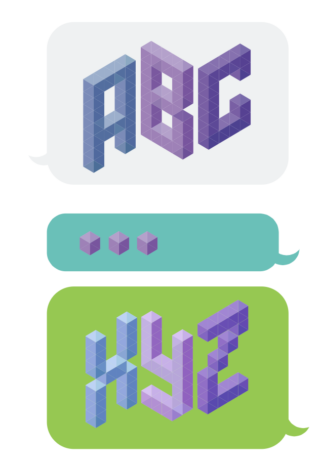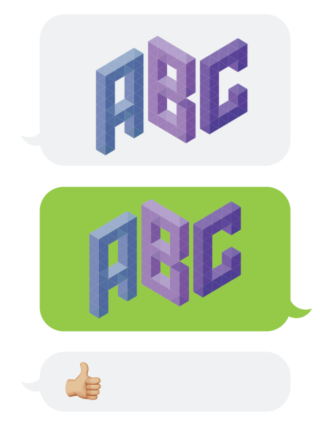Common Language for High Performance
Common Language is Building Block 2 to Design-Driven Digital Transformation by Jon Fukuda
This post is part two of a five-part blog series to cover each building block discussed in our webinar “5 UX Keys to Unlock Digital Transformation”. You can read about the first building block here. This building block focuses on building a common language across the organization as a core strategy for digital transformation.

What do we mean when we say human-centered digital transformation?
When defining “digital transformation,” – we use this definition coined by Growth Tribe – “Digital transformation is a human-led, tech-enabled, customer-centric process of continuous learning.” Unlocking your organization’s capacity to achieve a flow-state where transformation can be responsive and continuous requires a shared understanding, culture, and sense of destiny. When your organization builds a common language across departments, products and services, and cross-functional collaborators – culture, understanding, and destiny become emergent.
So what’s the problem?
The pace of technology, the vast pool of systems, tools, taxonomies, and domain-specific knowledge have only been made possible by subject-matter experts going deep into their areas of expertise. Along the way, these areas of expertise have established parallel, yet divergent vocabularies, measures of success, and agendas on the vast spectrum of enhanced digital experiences. As a matter of unintended consequence, formal or otherwise, our tribal nature establishes boundaries and silos to allow our specialized focus areas to deepen and yield value.
In the context of today’s design thinking and design sprint, our varied disciplines convene on a shared purpose – we ritualize spaces and moments to establish a shared understanding. We then move collectively to build experiments and design plans to challenge our assumptions. But what’s often glossed over, and continues to mire cross-functional teams outside these ritualized spaces, are our varied interpretations of common purpose in the context of our specific domains. Most alignment issues stem from differences in the mental models of our areas of expertise. Many will find that they use the same words, but their interpretation and meaning differ. While culture can be unintentionally emergent, high-performing cultures require focus and design to overcome these specific challenges.
Like anything, it’s easier to address the symptoms of a problem rather than the root cause. So we look at those symptoms:
- long meetings
- change requests
- improper scope
- misaligned requirements
- misset expectations
- [insert your collective pain point here]
“Culture work is necessarily emotional labor. It’s not only understanding the meaning behind a concept but also the emotional context attached to it. To take any human beings through a transformation – even the most seemingly rational ones – means dealing and working with all feelings that come with it.”
-Alla Weinberg, CEO Spoke & Wheel
As perpetual problem solvers, we try to analyze and pick off these problems with tactics, rituals, ticketing, kanbans, and tooling. While this helps move things along a rugged road (potholes, pitfalls, and all), they don’t address the root cause – lack of a common language. We see further evidence of the impact in:
- Delayed or retracted releases
- Hotfixes
- Longer design cycles
- Failed user acceptance tests,
- Bloating costs
- productivity loss.
Environments where these types of problems fester can become toxic and demoralizing.

“Engaging in an activity to understand each other’s mental models, surface assumptions, and come to a shared meaning/common language creates connection, and increases the psychological safety and health of company culture.
A lack of common language/mental models, it’s a sign of a cultural issue because people are transacting with each other at work instead of taking the time to relate and understand each other. This creates a culture of silos and leads to competition or territorialism and a disjoint customer experience.”
-Alla Weinberg, CEO Spoke & Wheel
Operationalizing Common Language
As it turns out, language is stubbornly rooted in our consciousness and difficult to shift in new contexts. But it’s not impossible. Once teams acknowledge their entrenched culture mismatches, they can start addressing the root cause. Language and understanding are often at the heart of the problem where there is new and abundant opportunity for breakthroughs that drive high-performing teams.
Attacking the problem of disparate language is easier with a tactical hit list.
- Assess the current state – ask teams to call out parts of cross-functional collaboration that are particularly high-friction. What are the behaviors, rituals, and common occurrences where function and communication break down? From these identified moments, what problems challenge alignment and communication? Which concepts, perspectives, terms, objects, or taxonomies live at the center of those challenges?
- Knowing is half the battle – once identified, ask your team to independently/asynchronously define the problematic items collectively identified in the exercise above. Each perspective on those items is valid and pertains to nuanced contexts and cognitive bias driven by our deep subject matter expertise. But that doesn’t mean there isn’t still work to do.
- Building affinity – Re-convene as a group to review and collect feedback on the unique perspectives that shape understanding in common language where terms have various meanings, interpretations, and implications, call them out, group them together into related themes – “process impact”, “system/business object”, “UI component”, “development impact” etc. By analyzing common and domain-specific language through shared lenses, we can establish common ground in how we work with and impact each other through the language we use.
- Culture and shared language is constantly evolving and takes care and feeding even after intentional workshops take place. Discuss aspirational outcomes from conducting these exercises (reduced churn, more efficient communication, shorter delivery cycles, etc.) And monitor those outcomes. If you’re not seeing the results you’d all hoped for, discuss new ideas for continuing to lean into ways your cross-functional collaborators can build common language and shared understanding – whether it’s through design sprints, tiger teams, or co-design/development, be creative and look for opportunities to build bridges.
- Don’t forget to address communication style differences which add another dimension to how we not only talk to each other but how we listen to and hear each other. Depending on your school of thought, it’s helpful to identify by type: Analytical, Driver, Expressive or Amiable. Dominant aspects of how we communicate can be put into quadrants to help identify attributes for how we speak and listen – or do or abstain. A collective awareness of these dynamics will help team members play to each other’s strengths and build higher performance.
- Finally – take this as an opportunity to extend your culture of continuous learning, just with your products and services, keep an ear to the ground on how language and cultural dynamics change over time and when they are due for a tune-up.
Calling in Reinforcements
Culture work, particularly on issues of language, knowledge-work, and subject matter expertise can get touchy and spark unintended conflicts. Sometimes it’s good to bring in a 3rd party mediator, someone outside your project team, or an immediate sphere of collaborators. And oftentimes, bringing in a seasoned expert who focuses on building a culture of innovation can bring with it a host of techniques to work through the tougher scenarios. Limina has been fortunate to work with Alla Weinberg over the years.
Contact Alla to learn more about her work at Spoke & Wheel where her practice focuses on Culture Design, Team Development, and Executive Coaching to address your team’s performance needs.
Summing it up
Addressing fundamental cultural issues among your cross-fuctional teams builds a strong foundation for tackling a design-driven approach to digital transformation. Keep an eye out for our next post where we discuss onboarding kits to curb-cut on and off ramps for team members and collaborators.
“70% of change initiatives fail because organizations miss the people piece of the equation. They don’t address the emotions that lead to silos, resistance, and sometimes even outright sabotage of change. Building cognitive empathy – which involves having a more complete and accurate knowledge about the contents of another person’s mind, including how the person feels – through a shared language is the key to unlocking a successful change effort.”
-Alla Weinberg, CEO Spoke & Wheel
Tactical Pro-Tip from Spoke & Wheel
Understand the different mental models in play. Have cross-functional teammates present the following:
- In “my land” concept X means (___)
- I am making the following assumptions when I hear X: …,
- This is the intended impact, …
Then the listeners reflect back on what they heard to make sure they understand correctly. They go back and forth until the presenter feels understood.
Then another person/team presents, and so on.
Once everyone has been heard, the group then develops “our terms” which is a shared mental model for key concepts or areas of miscommunication.

Alla is the CEO of Spoke & Wheel, a culture design company that helps organizations build cultures of safety. She is a culture designer & author who has incorporated her design background with the principles of neuroscience, positive psychology, and relationship research to offer the most customized and compassionate cultural solutions available.
In her book, A Culture of Safety: Building an Environment for People to Think, Collaborate, and Innovate, Alla delves into the tools, practices, and rituals that help leaders create physical, emotional, & psychological safety.